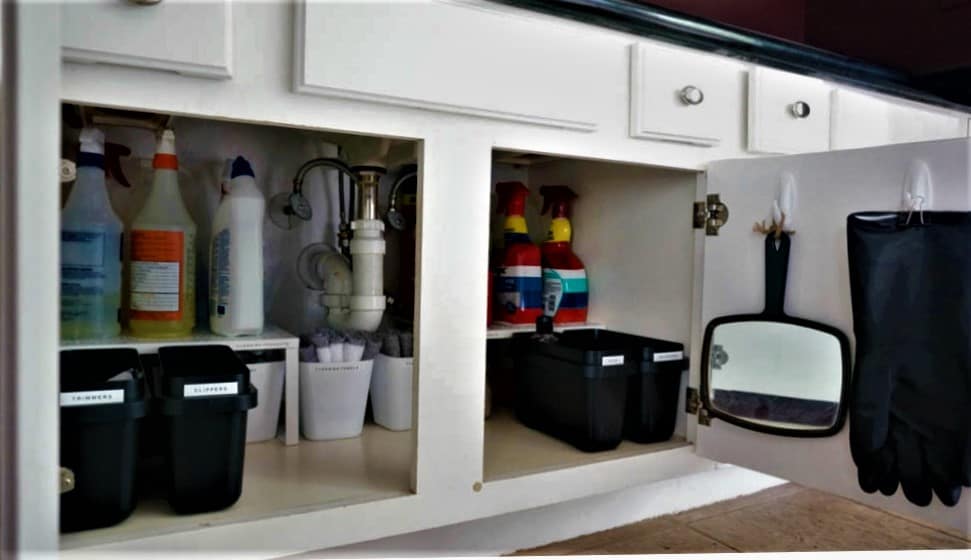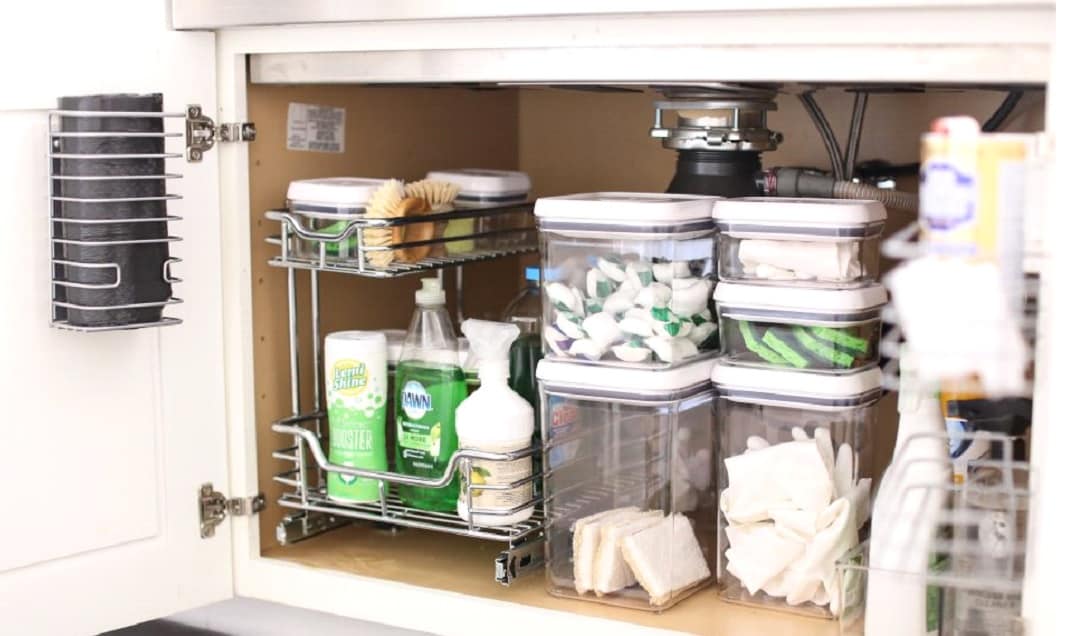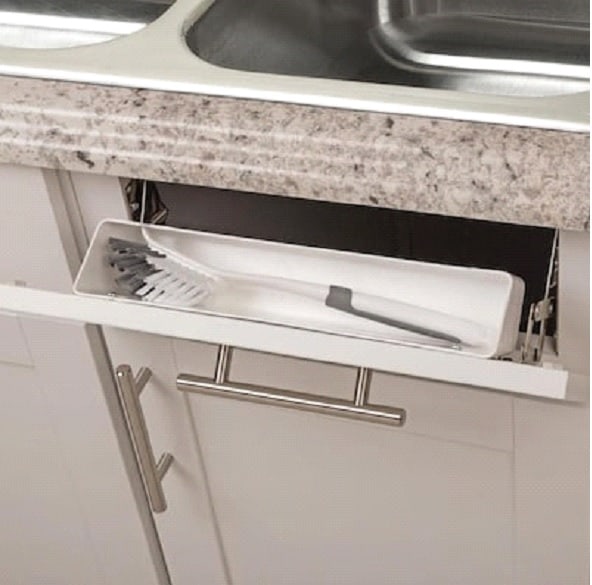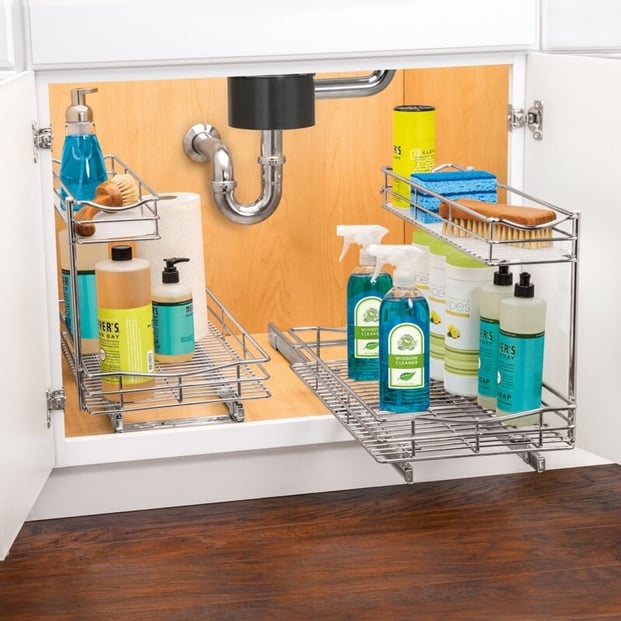
The kitchen is a busy, messy place that requires constant cleaning. It’s important to have cleaning products and agents well organized in convenient places with easy access. Primarily, the areas near and below a sink constitute the hub of cleaning activities because they’re near a water source. This space is also the best storage and organization center for cleaning products. When organizing your sink areas, plan to begin with what is currently in the base cabinet under the sink.
Decluttering the Sink Areas
Heat and moisture generated from the hot water pipe and the dishwasher hose can make the under-the-sink space dank and smelly, so test the disposal and check for plumbing leaks before organizing. Empty the entire under-the-sink area and then wash the cabinet floor, walls, and pipes. Measure the storage area and record the dimensions. Record the location and the amount of space occupied by the plumbing. Paint the area, if possible, and cover warped cabinet flooring with inexpensive vinyl or a sheet of laminate.
You can add adhesive air fresheners and mount a battery-operated light to help locate items. Gather all the soaps and lotions used at the sink that are now stored under-the-sink. Discard old bottles and the stuff you don’t like to use. Condense half-used bottles and jars into as few as possible. Keep one bottle of dish soap by the sink, and store the spares with the cleaning products under the sink. Surplus cleaning sponges and tools can be stored under the sink in a handled caddy. Keep these items in their original packaging or safely conceal them to protect from possible chemical exposure or bacteria. Gather all your rubber gloves and cleaning tools used at the sink, such as sponges and cleaning brushes. Discard all the old, broken, and worn items. Pitch anything that carries a bad odor, because that usually means bacterial growth. Keep one tool for dishes, glassware, and flatware and one for difficult scouring jobs. When necessary, one bottle brush can reside in the sink area, as well as a specialized fruit and vegetable brush. Sanitize and move all rest to a container.

Under-the-Sink Storage
There are many good organizers designed for under-the-sink storage. One popular organizer designed for this space is a two-tiered wire shelving unit, commonly referred to as an EXPANDABLE UNDER-SINK ORGANIZER, which easily adjusts to fit around sink pipes and garbage disposals. It’s made to stretch the width of the cabinet and has adjustable shelves. This organizer typically incorporates pullout baskets so items are easy to access in this hard-to-reach storage space. An assortment of two-tiered base-cabinet organizers is available, offering pullout compartments that are ideal for under-the-sink articles. A handled caddy organizer is another good one for this space. Handled caddies can carry cleaning products, dishwasher accessories, air deodorizers, sink accessories, and other household odds and ends to and from the places they’re needed in the home. The following items are logical belongings to keep in this space, along with good ways to organize them.
Cleaning Tools
Hanging any cleaning tool or accessory to fully dry in between uses is a good idea. The interior side of the under-the-sink cabinet door is a place to mount hanging hooks for such articles. It’s possible to hang items that don’t have holes or loops by creating tearproof ones using a grommet-setting kit.
Dishwasher Accessories
Since dishwashers are placed next to a sink, their accessories and detergents naturally gravitate under the sink. Store dishwasher detergents alongside dish soap, sink cleaners, brushes, scrubbers, and sponges to keep all cleaning items together.
All these items can be stored in a container for easy access, like a handled tote. In order to free up the tight space associated with an under-the-sink location, keep just one box, bottle, or tablet pouch container of detergent plus a single bottle of dishwasher rinse aid in this area. Place excess products with the cleaning supplies. Store dishwasher bags, ball cap washers, spare flatware baskets, or any device that is taken in and out of the dishwasher in one spot. A storage location under the sink might be too cramped to store these bulkier items. Since they tend to be used infrequently, store them in a single, labeled container and move it to an upper shelf, kitchen closet, or pantry.
Trash Liners
A wall-mounted rack organizer attached to the inside wall of the sink cabinet is a good place to keep trash liners. Use a handled container if you chose to store trash liners on the floor of the sink cabinet so they’re easy to access.
Portable Dust Pan Set and Plunger
A portable dust pan and brush set is a good item to store below the sink. The volume of spills that take place in a kitchen warrants easy access to a cleaning tool when full-size versions are stored outside the kitchen. Many companies that sell car care or camping products also sell these sets. Typically, portable brush and dust pan sets nestle together and have holes for hooks in their handles; hanging them anywhere below the sink is best. A short-handled plunger is an important tool to have under the sink. Mount a single-utility holder designed to store a broom on the interior wall of the sink’s base cabinet to hold the plunger and free up the cabinet’s floor space.
Towels and Rags
Keep towels near the sink out of sight by placing them on a mounted towel bar attached to the inside door of the under-sink cabinet. At this location, they’re easy to access and can line dry. Another idea is to mount a paper-towel organizer that holds a single roll onto the inside door of the under sink cabinet. This organizer can hold disposable shop towels, which are thicker and more absorbent than regular paper towels. Disposable shop towels are designed to soak up garage oil, making them good for common kitchen oil spills and messes.

Dishwasher Accessories
Since dishwashers are placed next to a sink, their accessories and detergents naturally gravitate under the sink. Store dishwasher detergents alongside dish soap, sink cleaners, brushes, scrubbers, and sponges to keep all cleaning items together.
All these items can be stored in a container for easy access, like a handled tote. In order to free up the tight space associated with an under-the-sink location, keep just one box, bottle, or tablet pouch container of detergent plus a single bottle of dishwasher rinse aid in this area. Place excess products with the cleaning supplies. Store dishwasher bags, ball cap washers, spare flatware baskets, or any device that is taken in and out of the dishwasher in one spot. A storage location under the sink might be too cramped to store these bulkier items. Since they tend to be used infrequently, store them in a single, labeled container and move it to an upper shelf, kitchen closet, or pantry.
Trash Liners
A wall-mounted rack organizer attached to the inside wall of the sink cabinet is a good place to keep trash liners. Use a handled container if you chose to store trash liners on the floor of the sink cabinet so they’re easy to access.
Portable Dust Pan Set and Plunger
A portable dustpan and brush set is a good item to store below the sink. The volume of spills that take place in a kitchen warrant easy access to a cleaning tool when full-size versions are stored outside the kitchen. Many companies that sell car care or camping products also sell these sets. Typically, portable brush and dustpan sets nestle together and have holes for hooks in their handles; hanging them anywhere below the sink is best. A short-handled plunger is an important tool to have under the sink. Mount a single-utility holder designed to store a broom on the interior wall of the sink’s base cabinet to hold the plunger and free up the cabinet’s floor space.
Towels and Rags
Keep towels near the sink out of sight by placing them on a mounted towel bar attached to the inside door of the under-sink cabinet. At this location, they’re easy to access and can line dry. Another idea is to mount a paper-towel organizer that holds a single roll onto the inside door of the under sink cabinet. This organizer can hold disposable shop towels, which are thicker and more absorbent than regular paper towels. Disposable shop towels are designed to soak up garage oil, making them good for common kitchen oil spills and messes.
In and Near the Sink Storage
Given that water, grime, and goopy soaps will constantly find their way around the sink region, keep a minimal amount of belongings in that space. Usually, a cluttered sink area is due to the lack of successful storage arrangements under the sink, which is why it’s always best to maximize that space for as many countertop items as possible. However, some items are better stored either in or near the sink, either due to their function or your personal preference.
Hand and Dish Soap
It’s convenient to place hand-pump bottles of dish and hand soap on the sink counter. Some dish soap is gentle enough for handwashing, which is good for this spot and eliminates the need for two different soap dispensers at this location. Sink or countertop holes once used for spray hoses or instant hot-water devices can be repurposed to hold a stationary pump, where the spout rests at the top and connects to a soap bottle beneath the counter. When you like to keep hand lotion near the sink, consider storing a tube in a kitchen drawer rather than a dispenser next to the faucet to reduce counter clutter.
Dish Racks
Opt for an over-the-sink adjustable dish rack whenever possible to free counter space since dish racks are counter-space hogs. Often times, countertop dish racks conveniently become storage centers for those who do not want to put things back in the cupboards. When hand-washing demands are low, simply laying out dish towels on the counter for wet dishware and glassware can get the job done without the need for a dish rack. Make a solid investment in a countertop dish rack when there is a demand for one. The best ones on the market are made by a company called Sabatier. Their dish racks have a slim design with removable parts so they store away easily. They are equipped with an expandable drainboard for additional storage which has an attached bi-directional spout for draining water into the sink. These dish racks also come with unique organizers such as removable stemware and flatware holders. Invest in a wine glass drying rack if you use wine glasses daily. Not only do wine glass drying racks display glasses well, but also they securely air dry them and eliminate drying streaks. You can situate this rack on your countertop near where you serve wine, not necessarily right next to the sink itself.
Cleaning Tools
Cleaning tools that reside in the sink region need to stay sterile and dry between uses, so their storage essential should both shield and offer drainage. A good organizer for this is a suction-mounted sink organizer with drain holes at the base. Another useful tool organizer is the compartmentalized saddle caddy that rests on the partition dividing a double sink.
Most cabinet sinks have room in the front of the basin to install a hidden tip-out tray, which folds out from a concealed false-cabinet drawer and has compartments to hold sponges and brushes. Handled bottle brushes can be stored in the flatware compartment located on a dish rack.
Sink Strainer Baskets and Disposal and Suction Stoppers
A spare removable strainer basket and disposal and suction stopper are handy to keep on hand since these smaller items have a tendency to disappear. Store these related items in the same spot, like in a drawer or cabinet next to the sink. Use an organizer caddy, labeled container, or cabinet door rack device to house them. Don’t store these items too far from the sink, because you could run the risk of forgetting about them: out of sight, out of mind.
Dish Cloths and Towels
Separate your “cleaning” dishcloths from the dishtowels used for drying or display. Dish clothes are usually smaller and square in shape, whereas dish towels are larger and rectangular. Count and inspect these items for tears and stains. Forward those in poor condition to your cleaning-rag supply, if you can spare them.
It makes the most sense to keep twice as many dishcloths as dish towels on hand because they tackle more jobs. The frequency in which you use your dishcloths and the number of days in between doing laundry will determine how many to have. Generally, four to six are enough if the laundry gets done once or twice a week. Dish towels, on the other hand, are largely used to dry items that are already clean or for display. Therefore, two to four dish towels are sufficient in the average home. Dishcloths and towels can be stored in a drawer near the sink or dishwasher since they’re mainly used there. You can also mount a stationary or slide-out towel bar on the cabinet door to hang dish linens. Hooks can also be mounted on a cabinet door when you install grommets to the cloth that forms secure holes for hanging. Base-cabinet pullout storage devices, like slide-out shelves and baskets, can house dish linens for easy access. Containerize linens stored below the sink to keep them dry and clean. Paper-towel organizers can also be installed near the sink. The underside of an upper base cabinet near the sink marks the perfect spot for such an organizer. They can also be mounted on a wall near the sink. A good assortment of countertop paper-towel organizers are available for this purpose.

